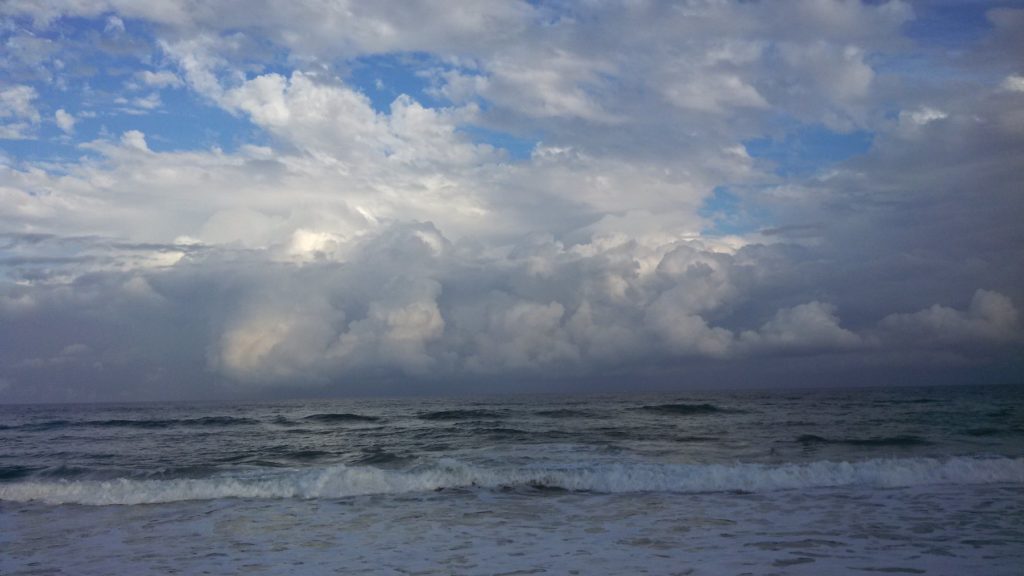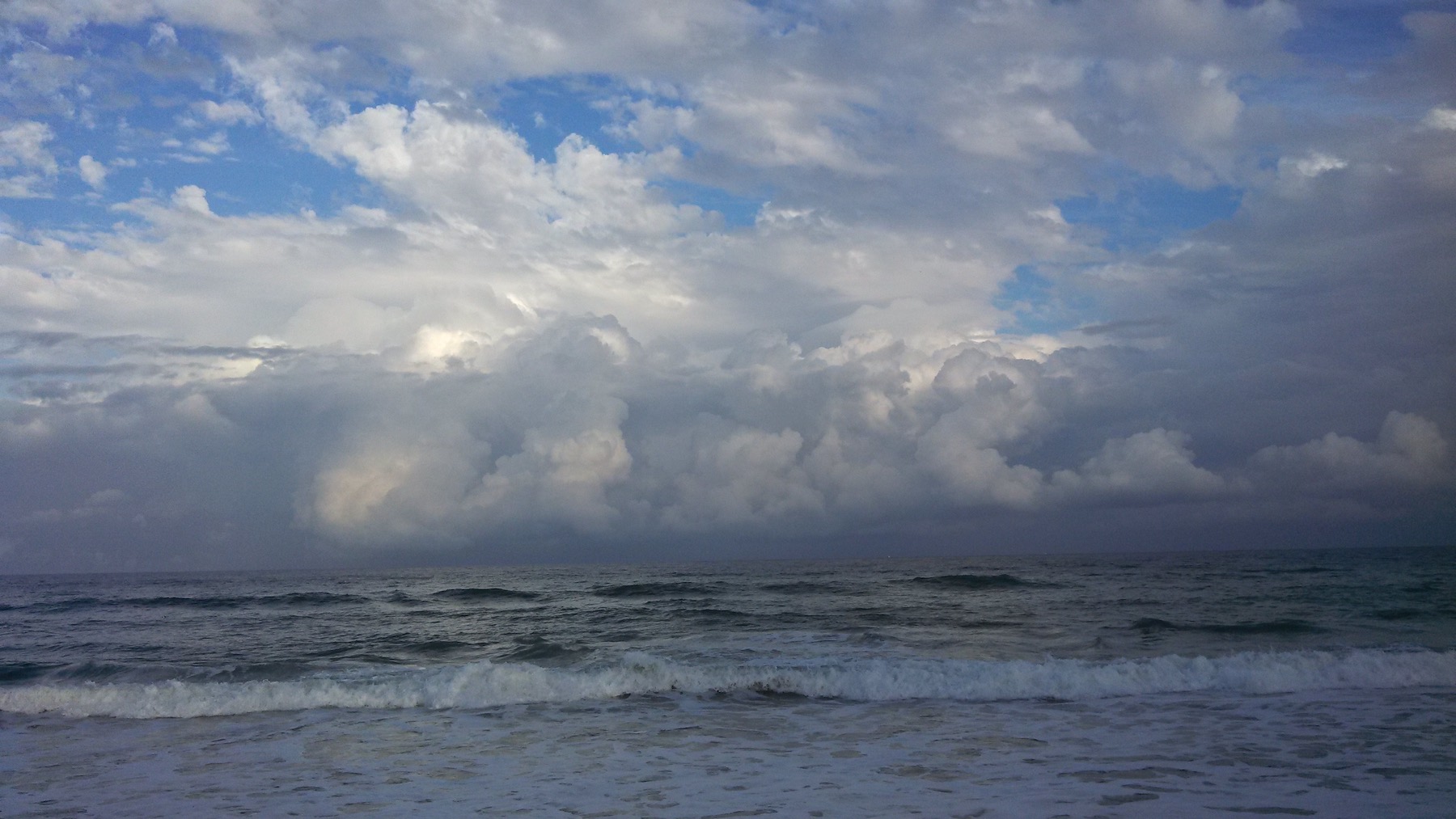
Florida, Atlantic Coast, February (Samsung 6)
CELLPHONE CAMERAS AND VISUAL ART
Here is the talk I gave at the Robert Floyd Photo Gallery in Southampton, Mass., February 25, 2018:
WE ARE LIVING in an age of rapid and profound change in communications technology, from cellphones to laptops to tablets, from Instagram to Facebook to Twitter. Change is happening so fast that we barely keep up.
We’re always learning how to use the latest device. There’s little time for critical thinking, and technology is a fast-moving target. What we talk about today may need readjusting in months.
Despite the dizzying pace, we have no choice but to soldier on, doing the best we can to not only learn to use the new technology, but to make sense of it, to put the new tools to our best use rather than having them lead us blindly on.
In my lifetime alone, I have seen photography and video technology evolve by leaps and bounds, from a hand-me-down Kodak Brownie and instant Polaroid as a child to my first single lens reflex camera, an Olympus-OM1, that came with my job as editor of the weekly Auburn News nearly 40 years ago, to my current digital cameras, Canon Rebel and Galaxy 6;
We’ve moved from Tri-X to Kodacolor film, black-and-white to color photos in our newspapers and magazines, to universal color online, anytime, anywhere;

Ice Storm (Samsung 6)
From rolls of 12 or 24 or 36 to limitless images;
From taking time and money to have film developed to same-day to one-hour to double prints to instant access, for free;
From analog to digital;
From ASA and ISO, f-stop and aperture to instant flash and automatic focus;
From camera case and lens cap and shoulder strap to my pocket;
From sharing with friends and family to thousands of strangers;
From photo album to Instagram to website;
From PMTs to PDFs. The Photo-Mechanical Transfers used to prepare line art in offset printing are a relic of the 1980s and 1990s. Now we save anything we want in a Portable Document Format that maintains its integrity whenever it is reproduced online or in print;
From boxes of unsorted prints spanning decades in my attic to endless file space on my computer, the cloud, and smartphone;
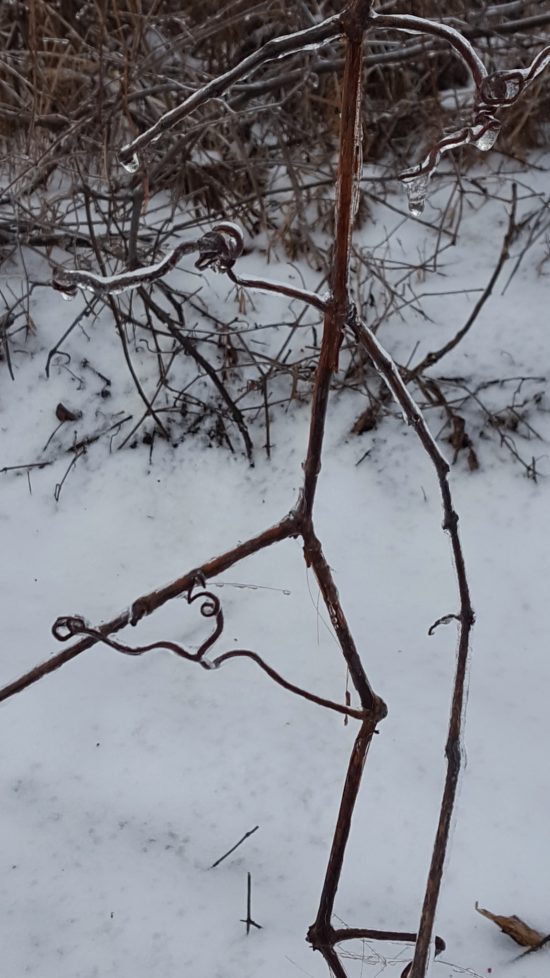
Ice Storm 2 (Samsung 6)
I have looked at these issues before. Here are two short essays from my book Feeling the Heat, about adapting to technological change. They already sound dated in places, although both were written within the decade. Still, questions about how we respond to new technologies are more timely than ever.
In addition to photography, during my lifetime there has been a steeper but corresponding trajectory in video, from expensive, bulky cameras to hand-held ones to our cameras and smartphones; from elaborate editing suites costing thousands of dollars to video editing programs on our smartphones and computers; from public access stations to YouTube, all in less than a generation.
* * *
MANY PHOTOGRAPHERS AND VIDEOGRAPHERS have split personalities. I am at least four types of photographer, and a videographer and producer.
Like most everyone, I am a chronicler of my home and family life, significant events, travel and vacations. I can never have too many pictures of the flora and fauna of Florida, my grandchildren, or my dog.
I use photography to try to express something artistic or deeply personal, attempting to distinguish the work in some way, through composition or angle, or color or light. I photographed the gardens I created over a five-year period to remake my front lawn in my book Living Without Lawn.
I have produced a number of videos, including educational programs for the New England Apple Association, and Shack Time, my 26-minute documentary about the artist shacks in the dunes of the Cape Cod National Seashore, which aired regionally on WGBH in Boston.
And for the past four decades I have worked professionally as a photojournalist, a marketer of colleges and a wide range of businesses, and for more than twenty years, as an educator and historian about New England apples. Photography has been an adjunct to writing in each of these vocations. I have taken and edited photos at every stop, and for the past seven years my photographs have been featured regularly in a weblog at newenglandapples.org. I publish the blog weekly from mid-August through November and intermittently throughout the year. (If you would like to receive it, send me your email address.)
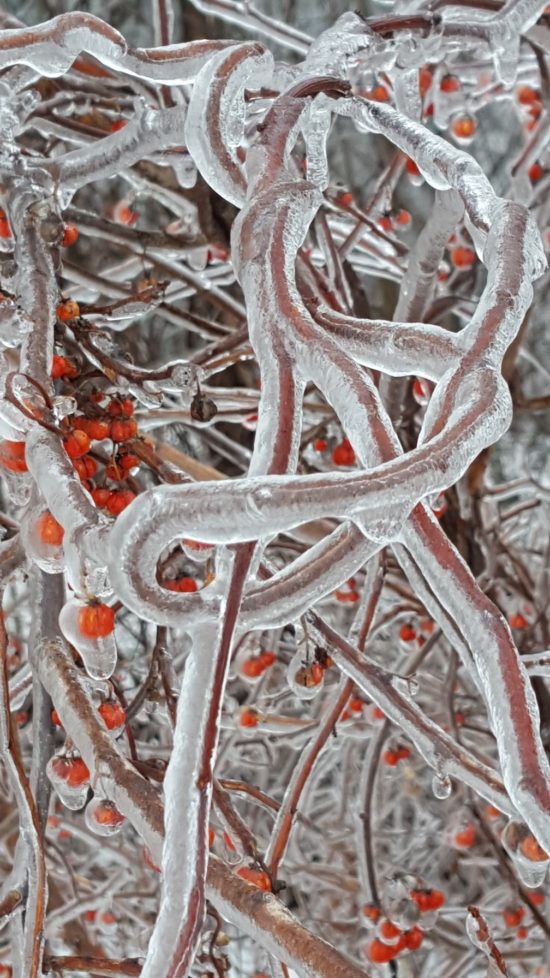
Ice Storm 3 (Samsung 6)
I am also a utilitarian photographer, taking images of my oil and acrylic paintings, and then cropping and resizing them to post on my website, Facebook, and Instagram, or printed on cards and announcements.
The photos are a poor substitute for the real thing, of course, particularly shrunk on a screen, and there is no creativity involved in composition. But the focus must be sharp and the colors accurate. From taking and preparing the photos to writing the text to laying out the design and adding tags and links to distributing it, a single post takes most of the day from start to finish, a costly but necessary investment to get my work out in the virtual world.
I am married to a photographer, Bar Lois Weeks. We work together to promote New England apples, and we are both members of the group Brook Hollow Arts. Among other things, Bar and I take photographs for an annual New England Apples wall calendar. (Email me if you would like one.)
Bar’s photographs will be featured in a presentation at the Old Mill Inn in Hatfield Wednesday, April 4, at 7 p.m., part of Brook Hollow Arts’ 2018 “First Wednesdays” series. She will be looking at early Hatfield history.
Bar’s photographs and my paintings are currently part of “Pas de Deux,” a group exhibit at Elusie Gallery in Easthampton, through March 3.
* * *
SO WHERE do all of these changes lead to in the here and now, in February 2018? What is the state of the art?
I mention four types of photographers — chroniclers, artists, professional, and utilitarian — plus videographers, and some of what I say today will not apply to all at once. And technological developments continue to unfold at warp speed. If there is one thing we can be certain of, it is that our cameras will become better and smaller every year, producing higher quality images that are easier to capture, manipulate, and disseminate.
But while we may lack certain answers in this environment, at least we can ask the right questions, and develop guidelines to help vet new technologies. Or as Socrates said, “The unexamined life is not worth living.”
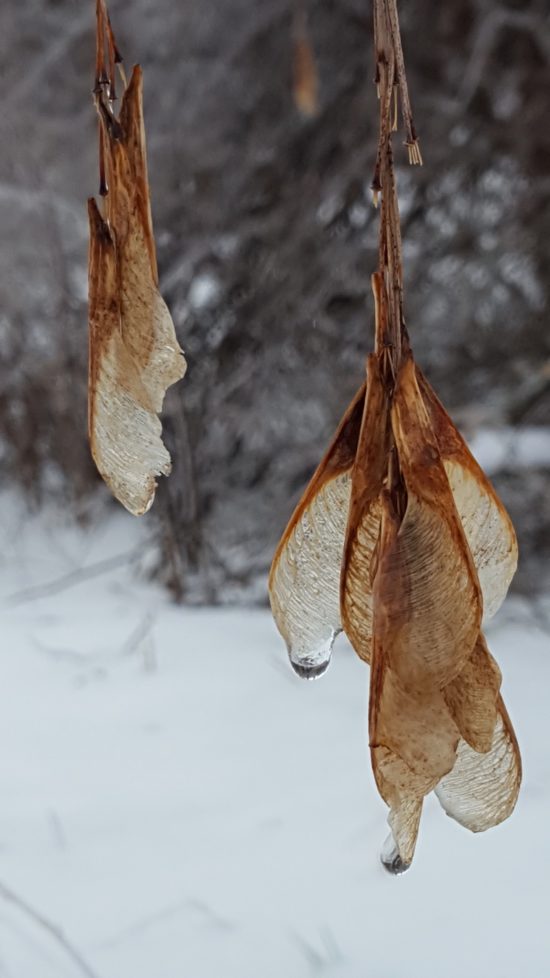
Ice Storm 4 (Samsung 6)
PERHAPS the biggest existential question hanging over all of this is why we do it at all.
Even when I paid dearly for my prints and film, I overdid it, taking too many similar shots of too many things. It’s the only way to learn, true. Whether you subscribe to Malcolm Gladwell’s theory that it takes at least 10,000 hours to attain mastery, or that it takes at least 400,000 images, as my friend Michael Zide once said, to make a good photographer, photography is a process that requires many snaps. Like any art form, it cannot be rushed, and there is no substitute for experience.
But my truly good photos, especially in my role as chronicler, oftten get lost in a sea of similar or mediocre images. I am always going to get to those boxes of photos in the attic to weed out the poor photos, but I never do. And if I did, what would I do with the good ones, other than return them to their envelopes?
I have several photo albums of prints I have culled over the years. Still, I have kept all the rest, good and bad, unsorted, and I have tons of negatives that will never be needed again. Yet I keep them (and my father’s negatives as well).
The digital age improves upon this spatially, but not in concept. The ability to take photos effortlessly at any time gives people endless time to get it right, without consequence. I take several photos of every painting in order to ensure one good one; the rest just take up space unless I go back and delete them.
Our photos take up space in our computers and smartphones and clouds until we summon them for printing, posting, or some other use. But the more we shoot, the harder they are to find.
So why do we do this?
Why do we step outside of an experience in order to document it?
Is it simply a joyful act; a different way of seeing the world; a path to self-discovery; a means to express beauty; a gift to our loved ones?
Or does it speak to our fear of mortality, our desire to preserve our youth, and to leave something lasting about our brief time on earth?
Is it vanity, an attempt to preserve what we find beautiful in ourselves?
Whatever your answers to these questions, here are some others that deserve our critical attention:
What does it mean when we all have cameras, at all times? In political terms, the cellphone camera offers a democratic means to publicize injustice and help the oppressed. The same cameras can also be used by the oppressor to spy on his or her enemies. The political implications of cellphones are huge, but that is not our topic today.
As a medium for visual art, the cellphone camera renders obsolete some of the technical skill that once distinguished the art or professional photographer. More and more of the technical process for making photographs is now automated. For the cellphone user, decisions about focus and aperture and lighting are passé. The main challenge is keeping one’s hand steady, and even that is easier with the lightweight device that fits in the hand than an unbalanced camera with lens.
Cellphone users instead choose between still images and video, and when to expend battery power. Video is becoming as easy as photography, and offers even more online platforms, like YouTube and Vimeo. With more moving parts there are more challenges. The zoom is clunky, and the audio on cellphone cameras is poor. But it will improve every year.
What will it mean when we all are capable of making our own movies?
* * *
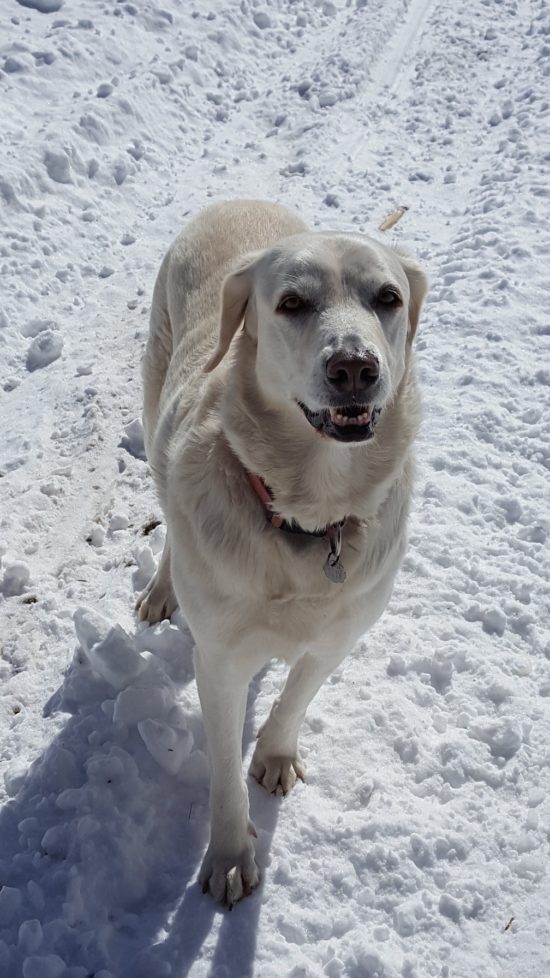
Molly-o (Samsung 6)
HOW SHOULD PHOTOGRAPHS best be viewed in the digital age? As a painter, my bias is toward the physical world of prints and frames and galleries. Whatever we display in cyberspace, we still have real-life walls to fill, art spaces to congregate. These continue to be the best places to discern quality and nuance, appreciate subtlety and size, tone and texture, experience the energy of people gathered together in the same room.
But what are the best options online?
The screen on my Samsung Galaxy6 is roughly 2½ inches by 4½ inches, smaller than the standard 4×6 prints that were once routine. Of course I can enlarge the digital images on other devices like tablets or laptops, and I can zoom in on details, a fabulous feature that I cannot do with a print.
But for ease of sharing spontaneously with family or friends, the full image, while crisp, is small. People often have to hunt for the images they wish to share, suspending the moment as they scroll through their files.
Standard resolution online is a mere 72 dots, or pixels, per inch. Still, file size can be an issue when attaching multiple photos to emails or posting them on software programs like WordPress, which supports my website. When I plan to print a photograph in a card or invitation, I must reformat it to at least 300 dpi and further reduce its size before sending it to the printer online. Video is even more problematic due to file size.
The question about why we take photographs comes into even sharper focus when we consider the possibilities of the Internet. Our photographs can now be scattered widely throughout cyberspace. For small, targeted lists, there is email or text. For social media, there is Instagram, Facebook, and websites, where anyone can see them. I use them all. (I do not use Twitter.)
I use these various platforms for several reasons. For one, they are a place to learn and practice. They are journalistic, chronicling my growth as a person and artist. They provide an audience, however small, supplying valuable feedback. As I am self-employed, social media is an effective and affordable way to market myself.
There are limits to this approach. Companies like Facebook that share my photos use algorithms to control who sees them. Instagram is limited to mobile devices, leaving me no choice but to use my smartphone camera. It takes more than a passive presence to be noticed in the sea of information out there. That’s one reason I post new content to my website and on Facebook at least once a month. People can lose interest if I post too little — or too much.
I rarely use social media for personal information. I consider anything I post online to be public and exist for all time. With few exceptions I am not willing to subject myself to that kind of scrutiny, much less my loved ones.
I do not manipulate my photos other than to make slight corrections in exposure. If the photograph is more than a little off, I need to reshoot. Given the current climate, where the integrity and veracity of news and information are under constant attack, sometimes for good reason, it is more important than ever that photographers and other artists show transparency in their work.
Although it does not interest me personally, I have no problem with photographers who use software to manipulate their images. Some of the results are stunning, beautiful and imaginative, and point toward new artistic frontiers, new aesthetics. But when I post a painting, I describe it: oil on canvas, for example, or watercolor on paper, and I indicate its size. I would like to see photographers do something similar, with labels like “iPhone9 with Photoshop,” so there is no hint of deception.
I am not a big fan of selfies, either. There is a long and honored tradition of self-portraiture in the visual arts, especially with painters, requiring time and thought and revealing something essential about the artist’s character. Selfies are more about narcissism. They are somewhat spontaneous but highly self-conscious and unrevealing, usually capturing a happy moment and preserving it for all time.
* * *
FOR THE MOST PART, these are process or technical questions and concerns. What are some critical issues posed by our cellphone cameras?
Liberated from many of the mechanics of producing a photograph, photographers can devote more of their energy toward developing a better eye, ceding some technical skill to focus more on artistic and content issues.
As with any camera, the cellphone camera is a means to increase our powers of observation, our engagement with the world. “The camera brings the visual world inside the photographer’s eye, body and heart,” writes poet Jonathan A. Wright in the introduction to his forthcoming book, Season of Dreams. Describing his time alone in the Provincetown dunes, he writes, “My eye gained a new focus and focal length through this new daily practice of watching and taking in.”
The prevalence of cellphone cameras has influenced me as a painter. I am less interested in strict representation of my experience, more interested in its traces, the emotional impact of what I see rather than a literal rendering. Representational painting requires great skill, and it can be quite expressive. Still, like the photographer who no longer needs to manually focus or adjust for light, I find a freedom, even an imperative, to explore other avenues toward self-expression.
As a culture, we have been shrinking from our engagement with the natural world in many ways, from our air-conditioned cars and homes to our hours in cyberspace to our time staring at our phones instead of being present to the moment. While in one sense taking a photograph also removes the photographer from direct experience, there is a far greater value in training one’s attention on some aspect of the physical world than not.
Manufacturers, software companies and Internet providers will continue to shape our photographic habits. Certain pages on my website take far too long to download, and the design is limited by templates. Instagram, as noted, steers photographers toward cellphones by only accepting images from mobile devices.
THE VIDEO POTENTIAL of our cameras is largely untapped. Part of it is habit; we have been snapping photographs for most of our lives, while the availability of video at our fingertips is relatively novel. The most prominent use of cellphone video to date documents events as they occur, to good and bad effect, from rescuing a baby duck from a storm drain or documenting police violence to criminal acts, even murder.
Within our cellphones is a lottery ticket, the possibility for notoriety or our 15 minutes of fame at any moment, as innocent bystanders or by deliberate act.
Video offers tantalizing possibilities for the visual artist. To be of lasting value, though, a video must tell a story. It is a good starting point and practice to follow a fast-moving stream, zoom in on a bird on a branch, or pan across a meadow. Sometimes the results are astonishing — the abstract close-up of the surging water, the bird as it flies off, the bee landing as I approach the flower. The power of moving images is that strong, our cameras that powerful.
But to sustain viewer interest and develop the potential of the medium, videographers need to push beyond the basic, one-take, narration free videos, piecing together stories using multiple shots and locations, and taking the time to edit them into a cohesive and meaningful narrative.
I made these simple videos, “Walking Dog Report” and “The Inscrutable Elephant’s Eye,” in September-October 2010 using a Kodak pocket video camera and iMovie.
VISUAL ARTISTS will always distinguish themselves by committing to the work — not just putting in the hours, but the right hours. That may mean making the effort to see other people’s work or doing research. It may mean getting up before dawn and venturing out in the cold, potentially slipping on ice, or lying on my stomach on a gravel drive, balancing on a tractor, or venturing out when I am feeling lousy.
Every moment is different, and light does not wait. The scene that is beautiful at noon may be stunning at dawn, but I may need to visit it seven times at dawn to get the shot I seek, only to discover that the image I really want is better at sunset.
***
HERE’S a more recent video, produced in April 2018. Recorded on Samsung Galaxy6 and Galaxy9S cameras, it played in the lobby of the Anchor House of Artists during the opening reception for “Streaming Hatfield,” an exhibit of my oil paintings, in April.
These three simple videos are examples of how the technology is changing, and what can be done at no cost using found sound and a little imagination.

